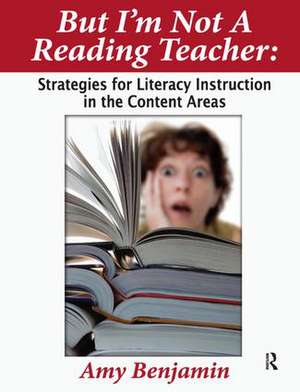But I'm Not a Reading Teacher: Strategies for Literacy Instruction in the Content Areas
Autor Amy Benjaminen Limba Engleză Hardback – 9 aug 2017
Preț: 625.03 lei
Preț vechi: 839.00 lei
-26% Nou
Puncte Express: 938
Preț estimativ în valută:
119.60€ • 125.13$ • 99.35£
119.60€ • 125.13$ • 99.35£
Carte tipărită la comandă
Livrare economică 02-16 aprilie
Preluare comenzi: 021 569.72.76
Specificații
ISBN-13: 9781138439733
ISBN-10: 1138439738
Pagini: 156
Dimensiuni: 210 x 280 mm
Greutate: 0.45 kg
Ediția:1
Editura: Taylor & Francis
Colecția Routledge
Locul publicării:Oxford, United Kingdom
ISBN-10: 1138439738
Pagini: 156
Dimensiuni: 210 x 280 mm
Greutate: 0.45 kg
Ediția:1
Editura: Taylor & Francis
Colecția Routledge
Locul publicării:Oxford, United Kingdom
Public țintă
Professional Practice & DevelopmentRecenzii
"If you are a content area teacher who has been known to think – or even say out loud – “I’m a _____ teacher, not a reading teacher,” then Amy Benjamin’s But I’m Not a Reading Teacher: Strategies for Literacy Instruction in the Content Areas is a must read. The book’s four parts provide examples, strategies, and practical applications for all teachers. Additionally, at www.amybenjamin.com, teachers will find more activities and classroom ready ideas for literacy instruction. Dr. Benjamin’s suggested strategies are sensible and easy for a busy teacher to implement."
—Anne Anderson for MiddleWeb
—Anne Anderson for MiddleWeb
Cuprins
Part I About Academic Reading; Chapter 1 Learning and Reading; Chapter 2 Scaffolding Vocabulary Instruction; Chapter 3 Standardized Tests and Reading Comprehension; Part II Academic Genres; Chapter 4 Academic Genres: Subject Area Reading; Part III The Strategies; Chapter 5 The Before-Reading Strategies; Chapter 6 The During Strategies; Chapter 7 After-Reading Strategy: Taking Ownership Through Wrap-Up Activities; Part IV Schoolwide Programs; Chapter 8 What Works? What Doesn’t?;
Notă biografică
Amy Benjamin, a veteran English teacher, trains educators throughout the country in writing across the curriculum, strategic literacy, and differentiated instruction. She has received awards for excellence in teaching from the New York State English Council, Tufts University, and Union College. As president of the Assembly for the Teaching of English Grammar, an affiliate of the National Council of Teachers of English, she is a leading authority on effective ways to teach both academic and creative writing. She is the author of eight books.
Descriere
"This new book is by two knowledgeable and expert popularizers of chemistry and deals exclusively with molecules and compounds rather than with the simpler atoms and elements. It is based on the very successful �Molecule of the Month� website that was begun by Paul May fifteen years ago and to which his co-author Simon Cotton has been a frequent contributor. � The authors � strike an excellent balance between introducing the novice to the world of molecules while also keeping the expert chemist interested. � I highly recommend this book to all readers. It will vastly expand your knowledge and horizons of chemistry and the human ingenuity that surrounds it."�From the Foreword by Dr. Eric Scerri, UCLA, Los Angeles, website: www.ericscerri.com, Author of �The Periodic Table, Its Story and Its Significance� and several other books on the elements and the periodic table.The world is composed of molecules. Some are synthetic while many others are products of nature. Molecules That Amaze Us presents the stories behind many of the most famous and infamous molecules that make up our modern world. Examples include the molecule responsible for the spicy heat in chilies (capsaicin), the world�s first synthetic painkiller (aspirin), the pigment responsible for the color of autumn leaves (carotene), the explosive in dynamite (nitroglycerine), the antimalarial drug (quinine), the drug known as "speed" (methamphetamine), and many others. Other molecules discussed include caffeine, adrenaline, cholesterol, cocaine, digitalis, dopamine, glucose, insulin, methane, nicotine, oxytocin, penicillin, carbon dioxide, limonene, and testosterone. In all, the book includes 67 sections, each describing a different molecule, what it does, how it is made, and why it is so interesting.Written by experts in the field, the book is accessible and easy to read. It includes amusing anecdotes
